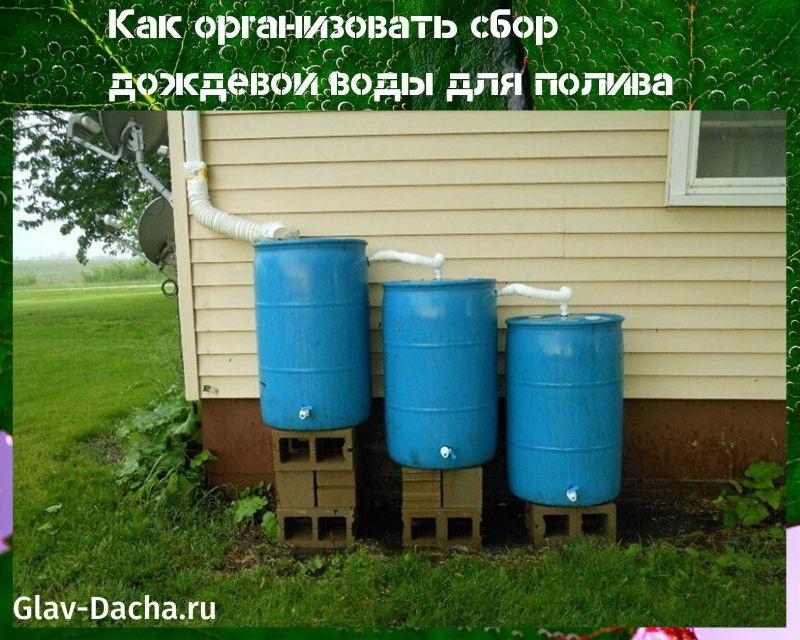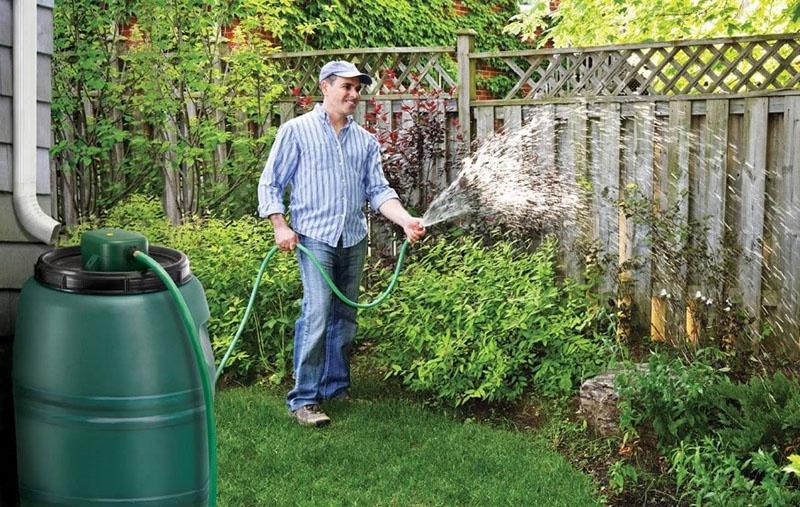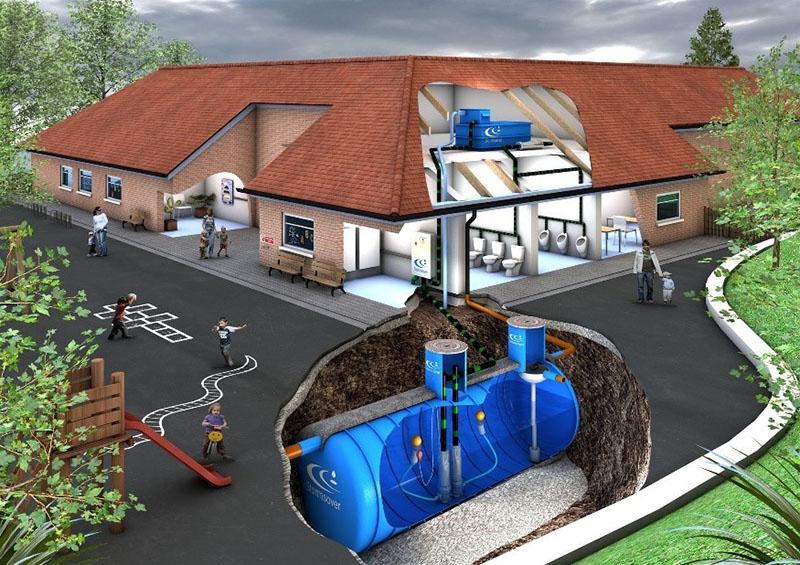How to collect rainwater for irrigation
 Harvesting rainwater for irrigating plants is beneficial not only economically, but also biologically. Rainwater collection devices should be installed even in areas where there is an autonomous water supply system, because rainwater is softer than the one that flows through the water pipe.
Harvesting rainwater for irrigating plants is beneficial not only economically, but also biologically. Rainwater collection devices should be installed even in areas where there is an autonomous water supply system, because rainwater is softer than the one that flows through the water pipe.
Using the collected water

With rainwater you can:
- Water plants. There are no metal impurities in this liquid, and all contained harmful components settle at the bottom of the container in which it is collected. Therefore, this water is ideal for watering any plants.
- Washing dishes. From an environmental point of view, washing dishes with rainwater is a great example of renewable production. It is more beneficial for nature to use water collected after the rain, and not pumped out from the depths. If each site owner saves water in this way, the level of ecology in the country will increase significantly.
 Another application is to create an autonomous water supply system. If you install a large storage capacity and connect a hydraulic pump to it, you will be able to create your own plumbing systemdepending on only one factor - the weather. You can connect communications from the bathroom to the dishwasher and washing machine to such a water supply. True, it will be necessary to install additional filters to purify water from impurities (otherwise, you can harm devices that are demanding on the quality of the liquid, such as dishwashers).
Another application is to create an autonomous water supply system. If you install a large storage capacity and connect a hydraulic pump to it, you will be able to create your own plumbing systemdepending on only one factor - the weather. You can connect communications from the bathroom to the dishwasher and washing machine to such a water supply. True, it will be necessary to install additional filters to purify water from impurities (otherwise, you can harm devices that are demanding on the quality of the liquid, such as dishwashers).
It is not recommended to collect rainwater near industrial production. The ideal place to collect is a plot in a village surrounded by forests and fields.
If there are industrial enterprises nearby, then their waste will accumulate in the clouds and, along with the rain, fall into makeshift reservoirs. It is highly discouraged to use such water in everyday life.
Collection of rainwater for irrigation

There are two ways to collect rainwater from the roof of a private house:
- ground;
- underground.
In the first case, you will have to allocate a free area on the site, in the second it is not required.
To apply the ground method you will need:
- Ebb tide on the roof.
- Barrel, tank or any other large container.
Collecting water from the roof into a barrel is the easiest option. Ebb tides are created according to such a system so that the point of discharge of water goes exactly into the container. The place of contact of the drain with the container is usually closed with a plug so that no dirt (for example, foliage) gets inside.
The container must have a valve for water intake. It is better to place it just above the bottom of the container, so as not to collect all the settling impurities with the water.
 The underground collection method is to create a well. The principle of operation is similar to that described above, only the construction device is much more complicated.
The underground collection method is to create a well. The principle of operation is similar to that described above, only the construction device is much more complicated.
A large container is buried underground, a drainpipe is led to it. The container can be connected pump and irrigation pipes that will allow you to organize an automatic irrigation system.
The organization of such a catchment is as follows:
- a foundation pit is created (do not throw out the soil, it will still be needed);
- at its bottom, a gravel-sand cushion is formed;
- a water tank is installed in the center;
- the tank is sprinkled with sandy loam on all sides;
- necessary communications are connected;
- a plug is placed on the neck;
- the container is masked by the previously extracted turf
From such a system for collecting rainwater from the roof, you can create an autonomous water supply system and connect all communications in the house to it (washing machine, shower, bathroom).
 Instead of a container in the ground, you can bury concrete rings and create a standard well. Bring a drain pipe to it, install a lever for water intake (a bucket with a drum and a chain) and that's it - the collection system is ready.
Instead of a container in the ground, you can bury concrete rings and create a standard well. Bring a drain pipe to it, install a lever for water intake (a bucket with a drum and a chain) and that's it - the collection system is ready.
Collection process

Two factors affect the speed and quality of water collection:
- Roof design and condition.
- Tank technical parameters.
- Execution of gutters.
The roof should be designed so that all the water from it flows down, and does not fall on the site, so it is not recommended to make sharp slopes.
The roof covering can be anything. The main thing is to keep it clean. For example, if the covering is made of slate, then it should be regularly cleaned of moss. In addition, the water grinds off the slate and its particles enter the reservoir.
The best option is galvanized metal. It does not corrode (if the zinc layer is not damaged) and biological growth does not appear on it.
 When choosing a container, you should adhere to the recommendation of having a metal frame around it. It doesn't matter which method of collecting rainwater for irrigation - ground or underground - we are talking about. The frame is additional strength, which, moreover, will help protect the tank from mechanical stress.
When choosing a container, you should adhere to the recommendation of having a metal frame around it. It doesn't matter which method of collecting rainwater for irrigation - ground or underground - we are talking about. The frame is additional strength, which, moreover, will help protect the tank from mechanical stress.
Special containers are on sale, stylized for exterior items. For example, columns. Although such architectural features are not always appropriate in a garden plot.
If the container is made of metal, then the water will contain particles of this substance, which will negatively affect its quality. The best option is plastic tanks for collecting rainwater for irrigation (when it comes to ground storage). When building an underground reservoir, special attention should be paid to the strength of the structure. In this case, not every polymer material will be able to compete with metal.
 The same goes for gutters... The use of metal options will negatively affect the quality of the water, but the plastic counterparts are perfect for collecting moisture in the rain.
The same goes for gutters... The use of metal options will negatively affect the quality of the water, but the plastic counterparts are perfect for collecting moisture in the rain.
An important requirement for all plastic objects in the drainage system is that the polymer must be opaque. Otherwise, water heating and its interaction with plastic cannot be avoided. As a result of the interaction, polymer particles will dissolve in water and change its chemical composition. Watering plants with this liquid can sometimes be detrimental to them.